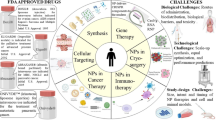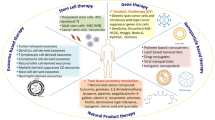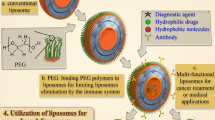Abstract
Purpose
Citral is composed of a random mixture of two geometric stereoisomers geranial (trans-citral) and neral (cis-citral) yet few studies have directly compared their in vivo antitumor properties. A micelle formulation was therefore developed.
Methods
Geranial and neral were synthesized. Commercially-purchased citral, geranial, and neral were formulated in PEG-b-PCL (block sizes of 5000:10,000, Mw/Mn 1.26) micelles. In vitro degradation, drug release, cytotoxicity, flow cytometry, and western blot studies were conducted. The antitumor properties of drug formulations (40 and 80 mg/kg based on MTD studies) were evaluated on the 4T1 xenograft mouse model and tumor tissues were analyzed by western blot.
Results
Micelles encapsulated drugs with >50% LE at 5–40% drug to polymer (w/w), displayed sustained release (t1/2 of 8–9 h), and improved drug stability at pH 5.0. The IC50 of drug formulations against 4T1 cells ranged from 1.4 to 9.9 μM. Western blot revealed that autophagy was the main cause of cytotoxicity. Geranial at 80 mg/kg was most effective at inhibiting tumor growth.
Conclusions
Geranial is significantly more potent than neral and citral at 80 mg/kg (p < 0.001) and western blot of tumor tissues confirms that autophagy and not apoptosis is the major mechanism of tumor growth inhibition in p53-null 4T1 cells.






Similar content being viewed by others
Abbreviations
- BW:
-
Body weight
- CMC:
-
Critical micelle concentration
- DLS:
-
Dynamic light scattering
- DMEM:
-
Dulbecco’s modified eagle medium
- EPR:
-
Enhanced permeability and retention
- FBS:
-
Fetal bovine serum
- geranial:
-
trans-citral
- i.v.:
-
Intravenous
- LE:
-
Loading efficiency
- MTD:
-
Maximum tolerated dose
- neral:
-
cis-citral
- NP:
-
Nanoparticle
- O/W:
-
Oil-in-water
- PBS:
-
Phosphate buffered saline
- PCL:
-
Polycaprolactone
- PDI:
-
Polydispersity index
- PEG-b-PCL:
-
Poly(ethylene glycol)-block-polycaprolactone
- SDS:
-
Sodium dodecyl sulfate
References
Maswal M, Dar AA. Inhibition of citral degradation in an acidic aqueous environment by polyoxyethylene alkylether surfactants. Food Chem. 2013;138(4):2356–64.
Kimura K, Nishimura H, Iwata I, Mizutani J. Deterioration mechanism of lemon flavor. 2. Formation of off-odor substances arising from citral. J Agric Food Chem. 1983;31:801–4.
Onawunmi GO. Evaluation of the antimicrobial activity of citral. Lett Appl Microbiol. 1989;9:105–8.
Korenblum E, de Vasconcelos Goulart FR, de Almeida Rodrigues I, Abreu F, Lins U, Alves PB, et al. Antimicrobial action and anti-corrosion effect against sulfate reducing bacteria by lemongrass (Cymbopogon citratus) essential oil and its major component, the citral. AMB Express. 2013;3(1):44.
Machado M, Pires P, Dinis AM, Santos-Rosa M, Alves V, Salgueiro L, et al. Monoterpenic aldehydes as potential anti-Leishmania agents: activity of Cymbopogon citratus and citral on L. infantum, L. tropica and L. major. Exp Parasitol. 2012;130(3):223–31.
Khan MS, Malik A, Ahmad I. Anti-candidal activity of essential oils alone and in combination with amphotericin B or fluconazole against multi-drug resistant isolates of Candida albicans. Med Mycol. 2012;50(1):33–42.
Helal GA, Sarhan MM, Abu Shahla AN, Abou El-Khair EK. Antimicrobial activity of some essential oils against microorganisms deteriorating fruit juices. Mycobiology. 2006;34(4):219–29.
Dudai N, Weinstein Y, Krup M, Rabinski T, Ofir R. Citral is a new inducer of caspase-3 in tumor cell lines. Planta Med. 2005;71(5):484–8.
Liu Y, Whelan RJ, Pattnaik BR, Ludwig K, Subudhi E, Rowland H, et al. Terpenoids from Zingiber officinale (Ginger) induce apoptosis in endometrial cancer cells through the activation of p53. PLoS One. 2012;7(12):e53178.
Liang CP, Wang M, Simon JE, Ho CT. Antioxidant activity of plant extracts on the inhibition of citral off-odor formation. Mol Nutr Food Res. 2004;48(4):308–17.
Yang X, Tian H, Ho CT, Huang Q. Inhibition of citral degradation by oil-in-water nanoemulsions combined with antioxidants. J Agric Food Chem. 2011;59(11):6113–9.
Djordjevic D, Cercaci L, Alamed J, McClements DJ, Decker EA. Chemical and physical stability of citral and limonene in sodium dodecyl sulfate-chitosan and gum arabic-stabilized oil-in-water emulsions. J Agric Food Chem. 2007;55(9):3585–91.
Park S, Hong C, Choi S. Citral degradation in micellar structures formed with polyoxyethylene-type surfactants. Food Chem. 2015;170:443–7.
Choi SJ, Decker EA, Henson L, Popplewell LM, McClements DJ. Inhibition of citral degradation in model beverage emulsions using micelles and reverse micelles. Food Chem. 2010;122:111–6.
Maeda H, Wu J, Sawa T, Matsumura Y, Hori K. Tumor vascular permeability and the EPR effect in macromolecular therapeutics: a review. J Control Release. 2000;65(1–2):271–84.
Woodward SC, Brewer PS, Moatamed F, Schindler A, Pitt CG. The intracellular degradation of poly(epsilon-caprolactone). J Biomed Mater Res. 1985;19(4):437–44.
Kwon GS, Yokoyama M, Okano T, Sakurai Y, Kataoka K. Biodistribution of micelle-forming polymer-drug conjugates. Pharm Res. 1993;10(7):970–4.
Soo P, Luo L, Maysinger D, Eisenberg A. Incorporation and release of hydrophobic probes in biocompatible polycaprolactone-block-poly(ethylene oxice) micelles: implications for drug delivery. Langmuir. 2002;18:9996–10004.
Park Y, Lee J, Chang Y, Jeong J, Chung J, Lee M, et al. Radioisotope carrying polyethylene oxide-caprolactone copolymer micelles for targetable bone imaging. Biomaterials. 2003;23:873–9.
Liu J, Zeng F, Allen C. In vivo fate of unimers and micelles of a poly(ethylene glycol)-block-poly(caprolactone) copolymer in mice following intravenous administration. Eur J Pharm Biopharm. 2007;65(3):309–19.
Savic R, Azzam T, Eisenberg A, Maysinger D. Assessment of the integrity of poly(caprolactone)-b-poly(ethylene oxide) micelles under biological conditions: a fluorogenic-based approach. Langmuir. 2006;22(8):3570–8.
Tsuboi S, Ishii N, Sakai T, Tari I, Utaka M. Oxidation of alcohols with electrolytic manganese-dioxide - its application for the synthesis of insect pheromones. Bull Chem Soc Jpn. 1990;63(7):1888–93.
Zeng S, Xiong MP. Trilayer micelles for combination delivery of rapamycin and siRNA targeting Y-box binding protein-1 (siYB-1). Biomaterials. 2013;34(28):6882–92.
Forrest ML, Won CY, Malick AW, Kwon GS. In vitro release of the mTOR inhibitor rapamycin from poly(ethylene glycol)-b-poly(epsilon-caprolactone) micelles. J Control Release. 2006;110(2):370–7.
Xiong MP, Forrest ML, Ton G, Zhao A, Davies NM, Kwon GS. Poly(aspartate-g-PEI800), a polyethylenimine analogue of low toxicity and high transfection efficiency for gene delivery. Biomaterials. 2007;28(32):4889–900.
Rosenberg B, Van Camp L, Grimley EB, Thomson AJ. The inhibition of growth or cell division in Escherichia coli by different ionic species of platinum(IV) complexes. J Biol Chem. 1967;242(6):1347–52.
Cleare M, Hoeschele J. Studies on the antitumor activity of group VIII transition metal complexes. Part I. Platinum (II) complexes. Bioinorg Chem. 1973;2:187–210.
Mai S, Muster B, Bereiter-Hahn J, Jendrach M. Autophagy proteins LC3B, ATG5 and ATG12 participate in quality control after mitochondrial damage and influence lifespan. Autophagy. 2012;8(1):47–62.
White E. Deconvoluting the context-dependent role for autophagy in cancer. Nat Rev Cancer. 2012;12(6):401–10.
Parajuli P, Pisarev V, Sublet J, Steffel A, Varney M, Singh R, et al. Immunization with wild-type p53 gene sequences coadministered with Flt3 ligand induces an antigen-specific type 1T-cell response. Cancer Res. 2001;61(22):8227–34.
ACKNOWLEDGMENTS AND DISCLOSURES
This research was supported by NIH grant R01DK099596 and startup funds from the University of Wisconsin-Madison, School of Pharmacy.
Author information
Authors and Affiliations
Corresponding author
Electronic supplementary material
Below is the link to the electronic supplementary material.
ESM 1
(DOCX 4872 kb)
Rights and permissions
About this article
Cite this article
Zeng, S., Kapur, A., Patankar, M.S. et al. Formulation, Characterization, and Antitumor Properties of Trans- and Cis-Citral in the 4T1 Breast Cancer Xenograft Mouse Model. Pharm Res 32, 2548–2558 (2015). https://doi.org/10.1007/s11095-015-1643-0
Received:
Accepted:
Published:
Issue Date:
DOI: https://doi.org/10.1007/s11095-015-1643-0




